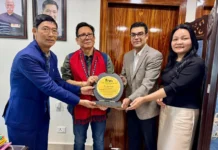Book Review
Folktales of Arunachal Pradesh, Vol-I
Edited By Batem Pertin, R.N Koley & S.Chanda
Directorate of Research, Govt. of Arunachal Pradesh
Page No: 178
Price: 250
[ Yater Nyokir ]
Folktales of Arunachal Pradesh Vol-I takes us on a journey into a supernatural and magical world. Reading the book was such a jubilant experience for me. It is learnt that this volume was released by living legendary litterateur YD Thongchi at the International Kolkata Book Fair, 2018. It is a must-read volume for those who are sincerely concerned about augmenting, promoting and preserving the rich cultural heritage of Arunachal Pradesh. It is a valuable documentation of tribal wisdom.
This anthology of folktales, edited by Batem Pertin, RN Koley and S Chanda, incorporates more than 30 folktales and myths from a diverse canvas of different ethnic communities of Arunachal Pradesh. A perpetual fountain of entertainment and knowledge, it is a comprehensive collection for readers of all age groups, and also for the academic audience.
Folktales, myths, legends and fables are an eternal part of the rich culture of Arunachal Pradesh. The dazzling introduction to this anthology beautifully elucidates the strength of folktales in the words: “Folktales of Arunachal Pradesh are the mines of indigenous wisdom which may be considered as valuable wealth of oral literature.”
The book is compartmentalized into two parts. The first part centres on famous folktales impregnated with moral values, humour, pathos and gentle lessons needed to be learned by the younger generation. The second part is infused with myths about the creation of the universe and the creation of the first man. These folktales are carefully drawn from all the major tribes of Arunachal Pradesh, such as Adi, Nyishi, Apatani, Idu, Monpa, Nocte, Singpho, Tagin and Wancho. It includes everyone’s favourite stories of the life and times of Abo Tani, and other interesting stories like How the Monkey Became Homeless, How Headhunting Came Into Being, and so on.
Sadly, today, the booming of varied and easily accessible entertainment sources such as cinema, television and mobile phones has changed the tastes and habits of the people. This interest in living stories poses a definite threat to folktales. The present generation hardly has the time and the interest to learn their culture. In such a critical juncture, folktales are important for one to gain cultural knowledge and understand the frameworks of the tribal culture of Arunachal Pradesh. The research directorate has made an effort to preserve these folk literatures of the ethnic communities before they fade out of the memory of the storytellers.
The simplest form of narration and language provides the scope for wider readership. If the lacunae of the book are to be deduced, it perhaps required a little more mindful editing, and a lighter touch of illustration would have added to the quality of the book; yet we cannot ignore the impetus of the documentation of the book. This enchanting collection of ageless folktales leaves us with a desire to read the succeeding volume.
So, if you are at all interested in folktales or are looking for something to do over the weekend, this is the book for you. (The reviewer is from Rajiv Gandhi University’s Department of Education)




